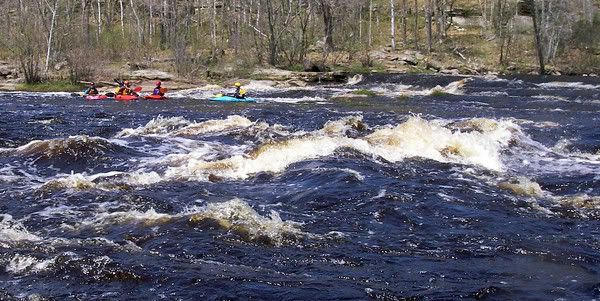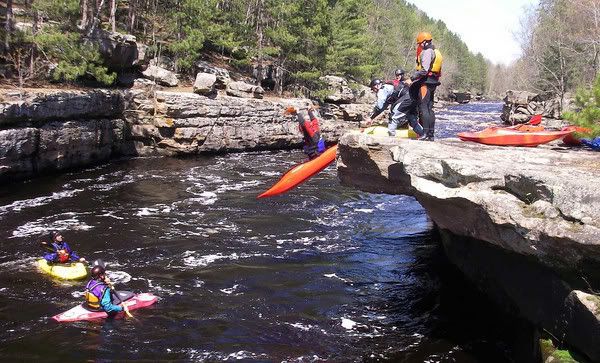
 Early this Spring I signed up for the Canoe U Refresher Course and spent a weekend with the Rapids Riders. The white water mentality is quite a bit different when it comes to rescues/rolling. A person could spend a lifetime paddling in a sea kayak and never need to learn to roll … as long as that paddling time is on relatively calm water. Even paddling on the Great Lakes if you choose your conditions carefully, a person could get by with basic self rescue skills. With white water, once you pop the spray skirt and bail … you are swimming, and not getting back in the boat. A self rescue at this point is not an option. Rocks, strainers, nasty holes, and all the bad things in the river you are now confronted with. You now have to rely on another person for rescue, and chase a boat down the river.
Early this Spring I signed up for the Canoe U Refresher Course and spent a weekend with the Rapids Riders. The white water mentality is quite a bit different when it comes to rescues/rolling. A person could spend a lifetime paddling in a sea kayak and never need to learn to roll … as long as that paddling time is on relatively calm water. Even paddling on the Great Lakes if you choose your conditions carefully, a person could get by with basic self rescue skills. With white water, once you pop the spray skirt and bail … you are swimming, and not getting back in the boat. A self rescue at this point is not an option. Rocks, strainers, nasty holes, and all the bad things in the river you are now confronted with. You now have to rely on another person for rescue, and chase a boat down the river.When I bailed out of the boat last spring and ended up swimming, Dave had to drag me out of the river, and Kent had the rather unglamorous job of chasing my boat down the river. But I hung onto my paddle, no way I was going to drop it. Dave drug me through two sets of rapids before he was able to catch an eddy and we were able to get to shore, and I still hung onto the paddle. I have to wonder why I felt it was so much more important to hang onto the paddle, than it was to keep trying to roll up. I know I would have eventually come up and stayed up. As a sea kayaker I have more options, I can roll, paddle float rescue, scramble back in, or with another person I do a T rescue. Even in 4 to 6 foot waves on Lake Superior, you have a fighting chance to get back in your boat. In white water, you are swimming.
So what made me choose plan b over plan a? I remember getting flipped forward and the feeling like the hole had a hold of the boat, and wasn’t letting go. I could feel the water trying to pull me out of the boat. I did try and sweep the paddle up for a roll, but couldn’t seem to get things into position quickly enough. Then a little wave of panic hit me. I grabbed the loop and pulled.
As a solo sea kayaker, if I go over on a 6 mile crossing and loose my paddle, I am toast. What I learned early on was DON’T LOOSE YOUR PADDLE! It may be far more important to learn early on to roll.
Years ago if a person wanted to get a pilots license, they had to do spin training. They had to take an airplane up high, induce a spin, and recover. Over the years designers made planes more spin proof, and the spin training was scaring people from learning to fly. So they dropped the spin training from the curriculum. Airplanes can still get into a spin if treated improperly, and a predictable number of people die in spins every year. I took aerobatic training early on as a pilot, and learned spins along with a lot of other fun maneuvers. I think it made me a safer pilot. I believe in spin training, and I think rolling should be taught as soon as a person starts kayaking, in a sea kayak or white water.
Photo credits to Chris G
No comments:
Post a Comment